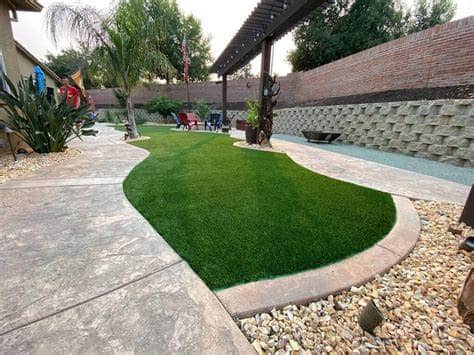How To Create Desired Landscape With Artificial Grass In San Diego Ca?

- Not all artificial grass is created equal. When selecting the turf for your landscape, consider factors such as pile height, blade shape, and color variation to achieve a natural look. Additionally, assess the durability and drainage capabilities of the turf, especially if you have pets or children who will be using the area frequently. Consult with a professional to determine the best type of artificial grass for your specific needs and preferences.
- Proper preparation of the ground beneath the artificial grass is crucial for ensuring a long-lasting and visually appealing installation. Begin by removing existing grass, weeds, rocks, and debris from the area. Next, ensure proper drainage by grading the surface away from buildings and installing a base layer of crushed rock or decomposed granite. Compact the base thoroughly to create a stable foundation for the artificial turf.
- To give your artificial grass a polished and seamless look, it’s essential to install edging and borders around the perimeter of the area. This not only helps to contain the turf securely but also prevents it from shifting or spreading over time. Choose from a variety of edging materials such as plastic, metal, or concrete to complement your landscape design. Secure the edging firmly into the ground to create clean lines and defined borders.
- Infill is a crucial component of artificial grass installations as it helps to support the blades, provide resilience, and enhance drainage. Choose an infill material such as silica sand or crumb rubber that is compatible with your turf and intended use. Spread the infill evenly across the surface and brush it into the turf fibers to ensure optimal distribution and stability. Avoid overfilling, as excessive infill can cause the turf to feel stiff and unnatural.
- While artificial grass requires less maintenance than natural grass, regular upkeep is still necessary to keep it looking its best. Remove debris, leaves, and pet waste regularly using a stiff brush or leaf blower. Rinse the turf occasionally with water to remove dust and refresh its appearance. Additionally, inspect the infill periodically and replenish it as needed to maintain proper support and resilience.
FAQs
Can Artificial Grass Be Installed Over Existing Concrete Or Pavement?
Yes, artificial grass can be installed over concrete or pavement, but proper preparation and drainage are essential to prevent issues such as pooling water and uneven surfaces.
Is Artificial Grass Suitable For Areas With Heavy Foot Traffic?
Yes, high-quality artificial grass is designed to withstand heavy foot traffic and maintain its appearance and durability over time, making it an excellent choice for areas such as playgrounds, sports fields, and commercial spaces.
How Long Does Artificial Grass Typically Last?
With proper installation and maintenance, artificial grass can last anywhere from 10 to 15 years or more, depending on factors such as climate, usage, and quality of the turf.
Conclusion
Creating your desired landscape with artificial grass requires careful planning, proper installation techniques, and ongoing maintenance. By following these five tips and addressing common questions and concerns, you can achieve a beautiful and functional outdoor space that enhances your home’s aesthetic appeal and enjoyment for years to come. For more information, contact Artificial Turf San Diego Ca at (619) 369-0049.